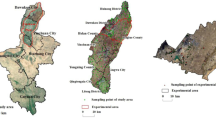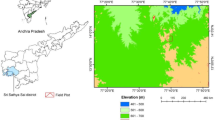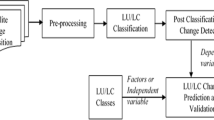Abstract
Two band simulad WiFS data for five dates correspfonding to rabi sorghun growing season of 1993-94 has been generated for Aurangabad district of Maharashtra. Ground truth data has been used for supervised classificatioa of one date raw image and five date NDVI of simulated WiFS data and the results were compared with those derived from single date IRS LISS I data. Analysis of classification accuracies indicate that single date WIFS data gives slightly lower accuracy of 79 per cent against 81 per cent obtained for single date LISS I data. Overall accuracy for 5-date WiFS data is 96 per cent which shows that classification performance of five date WiFS NDVI data is far superior to the single date data of the IRS-IC WiFS as well as the IRS LISS I. The study thus shows the importance of temporal domain of data acquisition in sorghum crop discrimination, Growth profile for sorghum and other crop classes were generated from multidate WiFS derived NDVI data. Differences in growth profiles of sorghum vigour classes as well as amongst different crop types and forests corroborate the premise of better discrimination of crop types and their vigour on multidate remotely sensed data.
Similar content being viewed by others
References
Anonymous (1995). IRS-1C data simulation and applications potential (Project Plan), SAC/RSA/ RSA/IPDPG/PP-05/July 1995 (unpublished).
Jonna S, Abdul Hakeem K, Murthy C S, Raju P V and Chari S T (1995). Evaluation of simulated IRS-IC WiFS data for concurrent monitoring of command areas at disaggregated level, J. Indian Soc. Remote Sensing, 4:185–194.
Mahey R K, Singh R, Sidhu S S, Narang R S, Dadhwal V K, Parihar J S and Sharma A K (1993). Pre-harvest state level wheat acreage estimation using IRS-IA LISS-I data in Punjab (India), Int. J. Remote Sensing, 14:1099–1106.
Navalgund R R, Parihar J S, Ajai and NageshwarRao P P (1991). Crop inventory using remotely sensed data, Current Science, 61:162–168.
Panigrahy S, Singh R P, Sharma S A and Chakraborty M (1995). Results of potential use of simulated IRS- IC data for crop monitoring, J. Indian Soc. Remote Sensing, 4:175–183.
Potdar M B (1990). Analysis of sorghum yield dependence on crop growth characteristics using NOAA AVHRR data, J. Indian Soc. Remote Sensing, 18(l):l-7.
Ray S S, Pokharna S S and Ajai (1994). Cotton production estimation using IRS-IB and meteorological data, Int. J. Remote Sensing, 15(5):1085–1090.
Sehgal V K, Bhatt H P, Bhagia N, Dubey R P, Dubey R C, Bidyanta S N, Deshpande U P. Ghatol S and Deotale S (1994). Rabi sorghum acreage and production estimation in Maharashtra using IRS multispectral digital data and time series analysis, Scientific Note: RSAM/SAC/CAPE-II/37/94.
Author information
Authors and Affiliations
About this article
Cite this article
Sehgal, V.K., Dubey, R.P. Evaluation of potential usefulness of irs-1c wifs simulated data for dryland rabi sorghum crop discrimination. J Indian Soc Remote Sens 25, 137–143 (1997). https://doi.org/10.1007/BF03024214
Issue Date:
DOI: https://doi.org/10.1007/BF03024214




